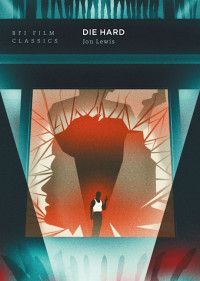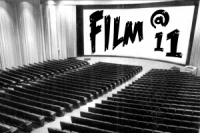


Jeff Godsil on the pre-Code Downstairs, with John Gilbert, Zatoichi the Fugitive from 1963, and a new BFI Film Classics on Die Hard.
---------------------------------------------------------
In 1999 film historian Kristin Thompson published her book Storytelling in the New Hollywood, via Harvard. Her thesis was that the so-called new Hollywood had not abandoned as much of old style Hollywood as was typically perceived, listing numerous still-current screenwriting structures and how the new Hollywood used them. One major innovation was to assert that screenplays do not have three structures, but four act structures each act about 20 minutes long with an important identifying transition, usually one in which the protagonist makes a firm decision. This section is followed by a survey of 10 films, such as the hunt for red October, and notes there for parts structures, and the various tropes and instruments and their time code. This book should've become one of the top leading film books of the year if not the following decade. There was a review in Creative Screenwriting, but otherwise little interest in the book from the Academy or from the writers Guild, at least that I could find.
Ms Thompson only mentions Die Hard a couple of times, but John McTiernan’s action thriller from 1988, but the film could very well have been, and this is underscored by Jon Lewis’s latest contribution to the British film institutes film Classics series, which is a treatment of the film.
[“In his previous film, Die Hard (1988), McTiernan had been less successful in integrating a surprise capper into the resolution. There the spectacular death of the main villain had seemed to lead into a epilogue as McClane and his wife emerge from the building. Yet suddenly the vicious henchman Karl, whom we had earlier seen apparently fatally throttled by a chain, emerges to threaten the couple once more. His renewed menace functions to close off the subplot involving the sympathetic cop Powell, who had told McClane that he is now desk-bound, unable to fire a gun as a result of accidently having killed a child. By shooting Karl and rescuing the McClanes, Powell presumably cures his phobia (a trajectory remarkably similar to Ryan's purging of his helicopter-accident trauma).” Thompson, P. 24.]
As in as his customary in the BFI series, the film comes in at a brisk 100 pages or so and is divided into a handful parts: An introduction with an unexpected personal note, a first chapter that elucidates the state of the nation at the time in the pre-9/11 terrorism European flavored space tropes; a look at the gender divisions in the film; an exceeds of the Whammy Theory of action films, which dictates that there be a big scene of violence or violent fist fight or a side of a car being decommissioned by bombs. Finally, in the last chapter of the undying matter of "is die hard a Christmas movie?" there are several interesting footnotes in the back, plus an extensive credit list.
Professor Lewis's thesis, in brief, is that central character John McLean is wrestling with a red definition of masculinity in the new ultra corporate, more liberal or democratic, at least in those days, world where there doesn't seem to be much room for a do it yourself, bureaucracy, hating, authority figure baiting loaner. He is “working class, libertarian/objectivist, anti-authoritarian, anti-intellectual, impulsive and improvisational.“ (P. 9)
“In its misdirection – a caper film promoted as a political thriller – Die Hard nonetheless expressed widely shared anxieties in the US concerning international security and stability, anxieties rooted in a seeming decline in American prestige and influence that would eventually fall under the rubric ‘the war on terror’ “(P.7). … Die Hard narrativises redress for perceived postwar slights, for a decline in American international prestige, economic super-power status and, after Vietnam, military eminence.”
“Much as we recognise the formula, we welcome the fundamental promise that both conflicts [Marital and criminal] will be resolved not in wordy arbitration, but in action instead. Die Hard is an American film, with violence being the most effective solution to everyone’s problems. … Action films as well as political thrillers – the genres in play in the A-story – work best when they seem realistic.”
The author tracks its production history, which started out as a Frank Sinatra vehicle that started out as a sequel to The Detective, and then summarizes the films reception and lasting place in American culture. Professor Lewis also Ty, the link between something that happened to him on a flight from Europe, to eight empty stray, refrigerator box that inspired the screenwriter at a crucial moment of stagnation.
Is chapter 3 is dedicated to the whammy theory, a notion attributed to producer, Joel Silver, and which dictates the frequency and content of action "numbers." hey then provides a complete list of 17 whammies in die hard.
This offers a good transition to some of the tropes and instruments that Kristin Thompson includes in her book. It's very much worth reading in full, but here is the short version.
The list of basic tropes includes dangling causes, the vocal trick cut,
“Hollywood favors unified narratives, which means most fundamentally that a cause should lead to an effect and that effect in turn should become a cause for another effect,,“ a transition to Dangling Cause and its concomitant, Closure. In short, everything is motivated.
hole." an unmotivated device is called a Hole. “Characters provide most of the motivations in any given film. Those motivations are based upon the traits of the characters … if a character behaves in a way that is contrary to his or her traits, the classical narrative will offer some explanation.”
Further on motivation, “the main character in a classical Hollywood film desires something, and that desire provides the forward impetus for the narrative. Hollywood protagonists tend to be active, to seek out goals and pursue them rather than having goals simply thrust upon them .” in other words, and active rather than a passive hero. An impediment is usually a Deadline:
“Often the protagonist in the former is under little time pressure to accomplish
his or her goal. “ Furthermore, “Hollywood films tend to convey information about deadlines, character traits, and indeed any sort of story factors redundantly..“ then there is the rule of three. For example, in silence of the lambs, “Similar information is given to Clarice by three different characters, conforming to the "rule of three" commonly used as a guideline for exposition in
the filmmaking community. “
“Within the scene, there is a host of stylistic devices that were created in the early years of Hollywood to achieve clarity. These include placing a distant framing of the action early in a scene to establish the locale and who is present n it. “ Variety is offered with the use of the Hook: “leave a cause open at the end of one scene and immediately pick it up in the next; such a transition is known as a "hook." For instance, a famous transition in Tootsie moves Michael Dorsey from his agent's office, where he defiantly vows that he will get a job, to the street, where he appears in drag- thus revealing how he intends to go about achieving his goal.” ”Frequently at the end of a scene a character will mention what he or she is going to do and then will immediately be seen doing it early in the next scene. Such a line is a "dialogue hook." another variant is a character affirming that she is positively not going to do something, followed by an abrupt cut to the character doing the very thing she denied. Voice overlap is dialogue from the next cut overlapping the preceding scene. This is something and only motion picture narratives can do not opera or plays.
“Another means of providing temporal clarity from scene to scene and across stretches of the narrative is the appointment. The appointment may act as a dialogue hook that reveals the time interval that the next scene transition will pass over.
“Finally, a film can achieve overall unity and clarity by means of motifs. These can be auditory or visual. The phrase "Pop quiz, hotshot" in Speed helps to pull the elevator, bus, and subway segments together. It also provides a snappy means of exposition, as when the protagonist's answer to the first pop quiz, “Shoot the hostage.“ The five yellow barrels that Quint uses to try to control the shark in Jaws provide a splendid example of the virtuosity with which modern classical films can handle motifs. The barrels serve a surprising number of functions.” … and are shown three times.
I might add unnecessary arrivals and departures. French Director Bertrand Tavernier shunned transitional of ,say, a person in a car, arriving at a place, getting out of the car, walking away from the car to the front porch, knocking on the front door, waiting,…
All of these instruments can be found in die hard. If you're academically inclined picking up these two books would provide quite a fall term filled with cinema knowledge.
- KBOO


